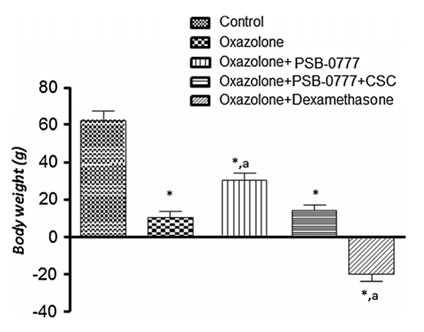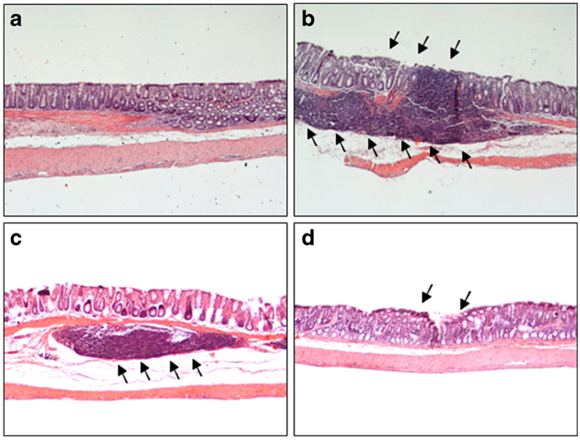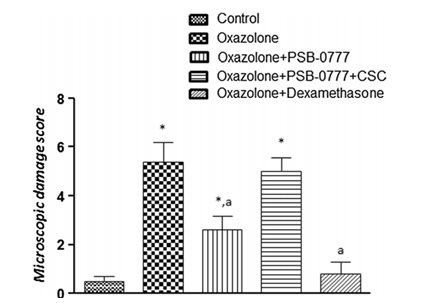Oxazolone Induced Colitis Model
Oxazolone (4-ethoxylmethylene-2-phenyloxazol-5-one), a classical haptenating agent, is known to induce colitis in rats/mice that resemble human ulcerative colitis. Oxazolone induced colitis is characterized by hemorrhagic inflammation, augmented epithelial microulcerations and histopathological changes in the distal part of colon. In addition, this colitis is mediated by Th2 driven immune response. Creative Bioarray has many years of experience in the field of ulcerative colitis and provides pharmacodynamic services for customers to help them assess the efficacy of compounds and study the associated pathological mechanisms of ulcerative colitis through oxazolone induced coliti model.
Our capabilities
- We utilize oxazolone induced colitis model to test the efficacy of drug candidates targeting IBD.
- We assess the severity of colitis through clinical analysis including weight loss, diarrhea and occult blood in stool.
- We evaluate various cytokines through IHC, ELISA, etc.
Assays available
- Clinical analysis
- Histopathological evaluation
- Analysis of mRNA and protein levels
- Cytokine/chemokine analysis
- Immunohistochemistry
With extensive experience in the field of IBD, we are confident to help you to overcome any upcoming challenges. Our experts are fully capable of customizing our protocols and assays to meet your specific needs. With our help, we wish to facilitate your research with high efficiency.
Study examples
 Figure. 1. Effects of PSB-0777 (0.4 mg/kg/day) alone or in combination with CSC (1 mg/kg/day) or dexamethasone (1 mg/kg/day) on body weight in rats with oxazolone-induced colitis. Each column represents the mean ± S.E.M (n = 6). *p < 0.05, significant difference versus control group; ap < 0.05, significant difference versus oxazolone group
Figure. 1. Effects of PSB-0777 (0.4 mg/kg/day) alone or in combination with CSC (1 mg/kg/day) or dexamethasone (1 mg/kg/day) on body weight in rats with oxazolone-induced colitis. Each column represents the mean ± S.E.M (n = 6). *p < 0.05, significant difference versus control group; ap < 0.05, significant difference versus oxazolone group
 Figure. 2. Hematoxylin and eosinstained sections of rat colon. Microscopic images refer to control rats (a) or oxazolone treated animals, either alone (b) or in the presence of PSB-0777 (0.4 mg/kg/day) (c) or dexamethasone (1 mg/kg/day) (d)
Figure. 2. Hematoxylin and eosinstained sections of rat colon. Microscopic images refer to control rats (a) or oxazolone treated animals, either alone (b) or in the presence of PSB-0777 (0.4 mg/kg/day) (c) or dexamethasone (1 mg/kg/day) (d)
 Figure. 3. Microscopic damage scores estimated for colon in rats under normal conditions or after oxazolone treatment, either alone or in the presence of PSB-0777 (0.4 mg/kg/day) alone or in combination with CSC (1 mg/kg/day), or dexamethasone (1 mg/kg/day) administration.
Figure. 3. Microscopic damage scores estimated for colon in rats under normal conditions or after oxazolone treatment, either alone or in the presence of PSB-0777 (0.4 mg/kg/day) alone or in combination with CSC (1 mg/kg/day), or dexamethasone (1 mg/kg/day) administration.
Quotation and ordering
If you have any special needs or questions regarding our services, please feel free to contact us. We look forward to cooperating with you in the future.
Reference
Antonioli L, El-Tayeb A, et al. Anti-inflammatory effect of a novel locally acting A2A receptor agonist in a rat model of oxazolone-induced colitis[J]. Purinergic Signalling, 2017.
For research use only. Not for any other purpose.
Disease Models
- Oncology Models
-
Inflammation & Autoimmune Disease Models
- Rheumatoid Arthritis Models
- Glomerulonephritis Models
- Multiple Sclerosis (MS) Models
- Ocular Inflammation Models
- Sjögren's Syndrome Model
- LPS-induced Acute Lung Injury Model
- Peritonitis Models
- Passive Cutaneous Anaphylaxis Model
- Delayed-Type Hypersensitivity (DTH) Models
- Inflammatory Bowel Disease Models
- Systemic Lupus Erythematosus Animal Models
- Oral Mucositis Model
- Asthma Model
- Sepsis Model
- Psoriasis Model
- Atopic Dermatitis (AD) Model
- Scleroderma Model
- Gouty Arthritis Model
- Carrageenan-Induced Air Pouch Synovitis Model
- Carrageenan-Induced Paw Edema Model
- Experimental Autoimmune Myasthenia Gravis (EAMG) Model
- Graft-versus-host Disease (GvHD) Models
-
Cardiovascular Disease Models
- Surgical Models
- Animal Models of Hypertension
- Venous Thrombosis Model
- Atherosclerosis model
- Cardiac Arrhythmia Model
- Hyperlipoidemia Model
- Doxorubicin-induced Heart Failure Model
- Isoproterenol-induced Heart Failure Model
- Arterial Thrombosis Model
- Pulmonary Arterial Hypertension (PAH) Models
- Heart Failure with Preserved Ejection Fraction (HFpEF) Model
-
Neurological Disease Models
- Alzheimer's Disease Modeling and Assays
- Seizure Models
- Parkinson's Disease Models
- Ischemic Stroke Models
- Acute Spinal Cord Injury (ASCI) Model
- Traumatic Brain Injury (TBI) Model
- Hypoxic-Ischemic Encephalopathy (HIE) Model
- Tourette Syndrome (TS) Model
- Amyotrophic Lateral Sclerosis (ALS) Model
- Huntington's Disease (HD) Model
- Intracerebral hemorrhage (ICH) Models
- Schizophrenia Model
- Pain Models
-
Metabolic Disease Models
- Type 1 Diabetes Mellitus Model
- Type 2 Diabetes Mellitus Model
- Animal Model of Hyperuricemia
-
Nonalcoholic Fatty Liver Disease Model
- High-Fat Diet-Induced Nonalcoholic Fatty Liver Disease (NAFLD) Model
- Methionine and Choline Deficient (MCD) Diet-Induced Nonalcoholic Fatty Liver Disease (NAFLD) Model
- Gubra-Amylin NASH (GAN) Diet-Induced Nonalcoholic Fatty Liver Disease (NAFLD) Model
- Streptozotocin (STZ) Induced Nonalcoholic Fatty Liver Disease (NAFLD) Model
- High Fat Diet-Induced Obesity Model
- Diabetic Foot Ulcer (DFU) Model
- Liver Disease Models
- Rare Disease Models
- Respiratory Disease Models
- Digestive Disease Models
-
Urology Disease Models
- Cisplatin-induced Nephrotoxicity Model
- Unilateral Ureteral Obstruction Model
- 5/6 Nephrectomy Model
- Renal Ischemia-Reperfusion Injury (RIRI) Model
- Diabetic Nephropathy (DN) Models
- Passive Heymann Nephritis (PHN) Model
- Adenine-Induced Chronic Kidney Disease (CKD) Model
- Kidney Stone Model
- Doxorubicin-Induced Nephropathy Model
- Orthotopic Kidney Transplantation Model
- Orthopedic Disease Models
- Ocular Disease Models
- Skin Disease Models
- Infectious Disease Models
- Otology Disease Models